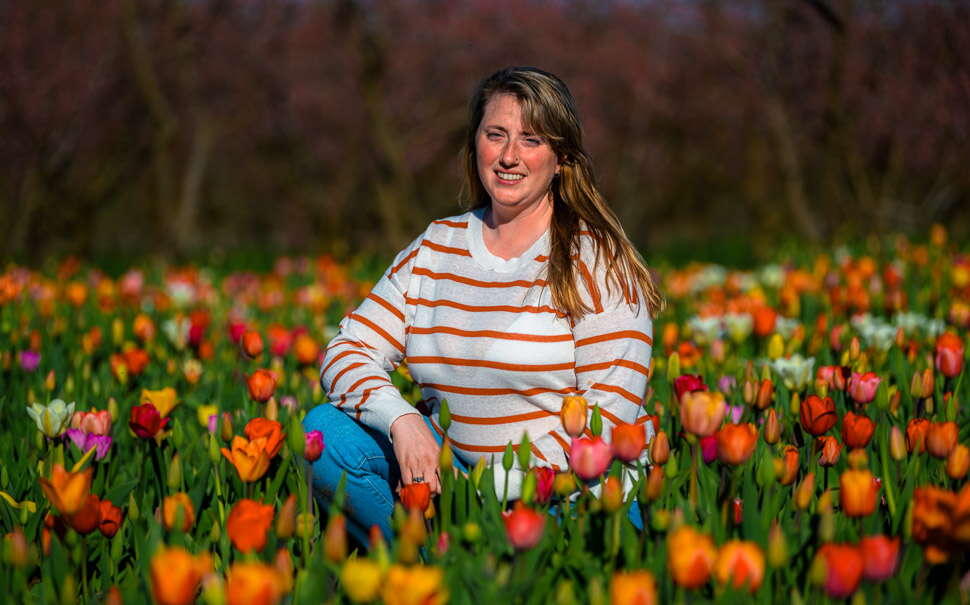
Charms of the farm: From goat hikes to flower festivals, Maine agritourism is thriving
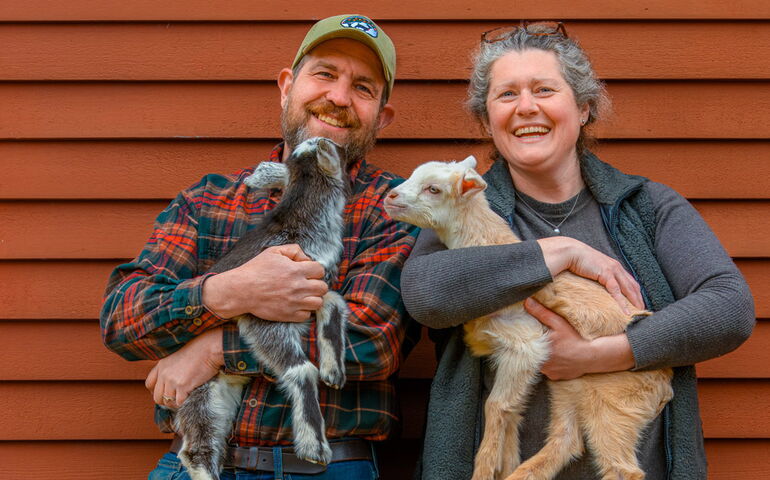 Photo / Jim Neuger
Karl Schatz and Margaret Hathaway, owners of Ten Apple Farm in Gray. They are holding 2-week-olds Sorrel (left), a male, and Rhubarb, a female.
Photo / Jim Neuger
Karl Schatz and Margaret Hathaway, owners of Ten Apple Farm in Gray. They are holding 2-week-olds Sorrel (left), a male, and Rhubarb, a female.
Down a sloping hill in Gray behind a weatherworn farmhouse built in 1901, more than a dozen goats are scurrying around their pen like children at a playground. Nearly all have beards and rounded horns, making it hard to tell males and females apart.
One pair playfully locks horns as others climb on boulders or munch on a pine branch. Taking it all in from the back of the pack is a wooly furball named Philip, a 7-year-old Romney sheep awaiting his annual haircut.
The whole herd — mostly French Alpine dairy goats — are the main attraction at Ten Apple Farm, where Margaret Hathaway and Karl Schatz offer guided goat hikes on the 18-acre wooded property they and their three daughters call home.
For short overnight stays, they rent out a three-bedroom Cape house touted on Airbnb as a “great goat getaway in southern Maine.”
“We started the diversified homestead just as a lifestyle, and as it become sort of an example farm for people, we leaned into that,” Hathaway says while sipping herbal tea at the family’s cluttered dining room table, one chair still decorated from her daughter’s 16th birthday celebration the day before. “Instead of selling people something, we’re selling them information …”
“Providing an experience,” adds her husband.
Like many farms across Maine, Ten Apple Farm has found its niche in agritourism, broadly defined as any commercial activity that brings visitors to a farm or ranch.
After honeymooning at an agriturismo in Italy’s northwestern Piedmont region, the couple spent a year visiting goat farms across the U.S. with plans to raise their own. Over time, goat hikes with friends in Gray evolved into a business that boomed during the pandemic and has been going strong ever since.
Schatz notes that while the tourism part of agritourism is new to some farmers, others start with hosting in mind. Regardless of the path, “you can’t get into agritourism not knowing about agriculture, and you can’t get into agritourism not knowing about hospitality.”
Business boom
Nationwide, 28,617 agricultural businesses earned an income from agritourism or recreational services in 2022, according to the latest census by the U.S. Department of Agriculture.
While the number is little changed from 28,575 in 2017, the average gross income per farm from those activities went up 32% from $33,222 in 2017 to $44,004 in 2022.
In Maine, out of 7,036 total farms and ranches counted in the 2022 census, 241 or 3.4% of the total earn money from agritourism. That puts Maine among the top 10 states in terms of the proportion of farms active in agritourism, and well above the 1.4% U.S. average.
While the number of Maine farms engaged in agritourism was little changed from 2017, income from those activities nearly doubled in Maine, from $6.6 million in 2017 to $12.2 million in 2022. The increase comes as the number of farms and farmland continues to dwindle.
But the numbers reflect only part of the picture, since the USDA’s tally excludes direct farm sales such as pick-your-own produce or wine purchased after a complimentary vineyard tour, as noted in a May report by the Northeast Regional Center for Rural Development.
Instead, those and recreation-related activities are counted among $172.6 million in Maine agricultural products sold in 2022 directly to consumers, institutions, retailers, restaurants and food hubs.
“The business landscape for Maine agriculture is changing rapidly,” says Jason Entsminger, an assistant professor at the University of Maine and adviser to small businesses.
“Lots of people sought to reconnect with traditional, slow-food ways, and looked to rural areas as a refuge where they could recreate, adventure and travel,” he says. “Many farms pivoted, experimenting with new elements of their ventures that engaged these consumers.”
To maintain the momentum, “we want to ensure the rapid scaling of agritourism activity remains sustainable for businesses and communities.”
Tiptoeing into tulips
Maine’s evolving agritourism sector is sparking a range of business models.
Offerings vary from the traditional to the innovative, spanning goat yoga and guided hikes like the ones in Gray to flower festivals and themed events. That’s giving entrepreneurial owners a supplemental, often more lucrative, and less labor-intensive source of income beyond growing crops or raising livestock — and bringing fresh ideas and new people to shake up one of the oldest industries.
Newcomers include Jessi Chmielewski, a 2020 graduate of the University of New Hampshire who moved to Maine in 2016. She and her husband, Wayne, grow salad greens and greenhouse tulips on leased land in West Newfield as well as tulips in an Acton fruit orchard they are in the process of buying. The couple planted all 100,000 bulbs themselves last autumn.

There are 42 varieties in all, mixed rows of bright red, oranges, purples, yellows popping on a sunny late afternoon like a mini-Netherlands in York County. While Jessi is hard-pressed to pick a favorite color, her barefooted husband says, “I’m a sucker for traditional red.”
Chasing after their 18-month-old son Riley, the couple were days away from the start of a month-long Blossom and Bloom festival featuring you-pick tulips, music, makers’ market and food trucks every weekend in May; season passes to visit the tulip field cost $23, or $86 for a family of four to six.
Eventually planning to live on the farm with their growing family, the couple like the idea of running their business close to home and spending less time running around to farmers’ markets.
Along with 19 of their peers, they recently completed a one-year pilot course run by Maine’s Department of Agriculture to learn the marketing, risk management and public relations and hospitality skills to run an agritourism business.
“The guy we are buying the orchard from, he’s been doing u-pick for 40 years, and says that’s really where you’re making the money,” Chmielewski says. “When people are coming to you, not only are they buying your product, they’re also paying for an experience.”
The plan is to remove all of the bulbs and plant anew next autumn, possibly adding daffodils and hyacinths.
While tulips will always be the star of the show, next year’s numbers are uncertain amid a warning from a Dutch supplier about a shortage in that country this year due to a wet season.
“I really want to do a winter, German-inspired market where we light up the entire market with Christmas lights,” Chmielewski says. “We’ll try to get through other things first.”
Midcoast cherry orchard
In the midcoast town of Bremen where hundreds of flowering cherry trees are flush with pink blossoms, Kerry Payne Stailey is a self-taught cherry farmer with a background in international consulting and photography.
She and her husband, Justin Stailey, both of whom are photographers, moved to Maine about seven years ago from Brooklyn, N.Y., where they lived down the road from the Brooklyn Botanic Garden. Charmed by its cherry trees, they set out to plant their own orchard on Maine’s midcoast.
“I fell in love with them and determined that if they were happy with this climate, we would create our own, little Brooklyn Botanic Garden,” says Stailey.
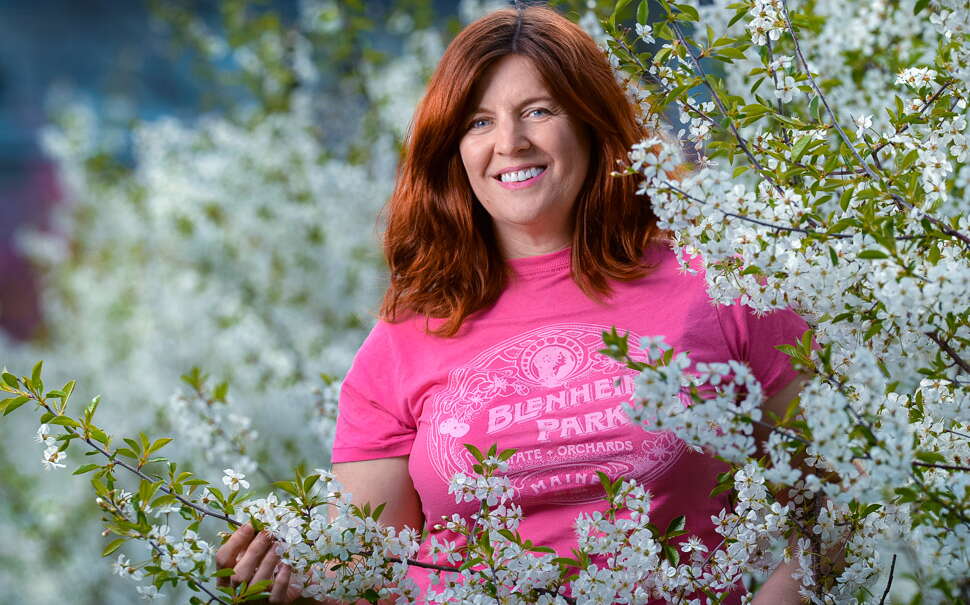
They built Blenheim Park as a 16-acre creative retreat and orchard on a lakefront property that dates back to 1924.
“Blenheim” refers to the chestnut and white coloring of the couple’s Cavalier King Charles Spaniel dogs, 11-month-old Willie Nelson and his 13-year-old brother, Stubbs. The property was named for Stubbs and the late Dizzy Ginger, a female Cav who died of cancer two years ago; both are depicted on a postcard and logo by a Latvian graphic designer.
Home to 200 sour-cherry trees planted seven years ago and 150 ornamental flowering trees of more recent vintage, Blenheim Park Estate and Orchards hosts events and photography workshops from May through late October, makes and sells a wide range of cherry-derived products from cocktail infusion kits to high-end bath and body products and rents out two lakeside cabins on the VRBO short-term rental platform.
This season’s events include an annual harvest and long lunch party in July, a “Prohibition Tipple — Roaring 20s Lawn Party” in August and a five-day photography workshop in September with the award-winning George Nobechi of Japan.
Keeping with the vintage theme, picnics feature old-fashioned lawn games like croquet, tug-of-war, badminton and horseshoes — “just stuff that helps you slow down and take a step back from this digital life that we lead,” Stailey says.
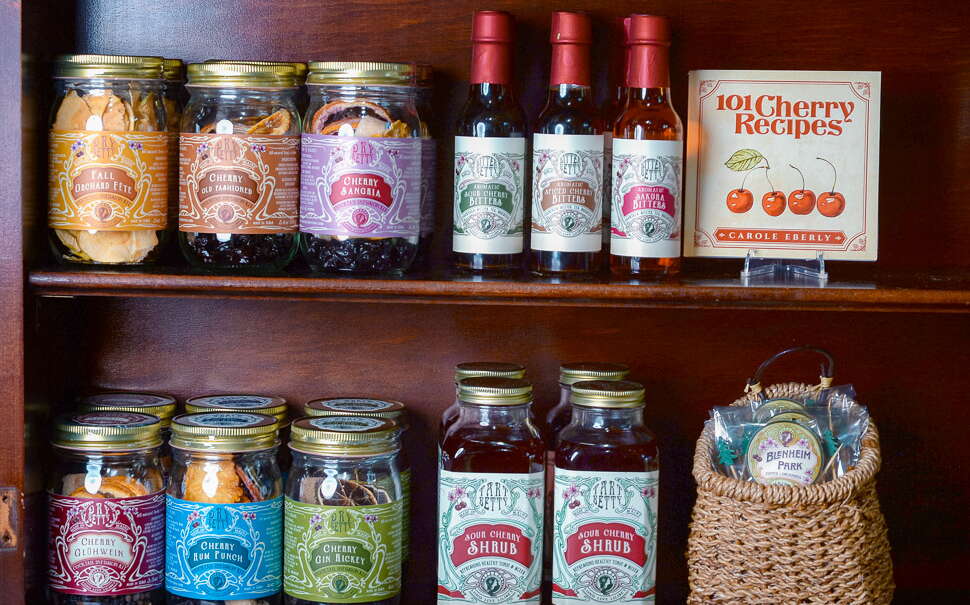
Noting Maine’s deep agricultural roots, she says, “A lot of local producers have been engaging in agritourism for some time here. It just hasn’t been called that.”
Running the business is no picnic for the Australian-born business owner and volunteer SCORE mentor, who learned about farming via YouTube videos and uses thousands of ladybugs every year to rid the trees of nutrient-depleting insects called aphids.
Clover and wildflowers are also left alone throughout the orchards for bees to pollinate, “so we don’t need to be taking anything away from the land.”
Cherry farming requires patience, since the trees typically don’t start producing until their fifth year and Blenheim Park’s are just starting to reach full production. Payne said she expects to harvest around one ton of fruit every year within the next couple of years, and that 18 ornamental trees planted six years ago as 4-foot saplings now stand 20 feet tall.
“We’re eager to see the entire orchard reach this size a few years from now,” she says.
‘Shift the model’
Overnight accommodations on farms vary widely, from empty fields for RV hookups to cottages, yurts and farmhouse bed-and-breakfasts.
As a member of the nationwide Harvest Host network, Eureka Farms in the Somerset County town of Palmyra regularly hosts overnight visitors in campers on its 185-acre maple farm.
Though visitors can only reserve for a night, Hollis Edwards — who owns the farm with his son, Seth — says the arrangement is good for both parties.
“It gives them a great place to stay in one of our fields, and they can go in our store and buy whatever they want,” or shop on the online store later, he says. While temporarily stepping back from hosting this year to work on other projects, he remains a fan of Harvest Host which he recommends to other farmers.
“If the only place you’ve got to put a camper is beside a manure pile, you can be a Harvest Host,” he says.
Opting for a different formula at Old Crow Ranch in Durham, Seren and Steve Sinisi added a 69-square-foot tiny house for guests in 2019. They raise pasture-based pork, beef and chicken on a farm they bought in 2008. Called the Crow’s Nest Tiny House, the year-round lodging can accommodate up to four visitors, with bookings busiest in summertime.
Besides selling their meat and other local products at their farm store, the couple host events from potluck pig roasts to “Date with a Farmer” educational visits.
“We’re paying our bills and building what we’ve got, but the profit margin is still pretty low for the intensity of the work,” Seren says. “My hope is that we can shift the model to less animal units, or seasonal animal units, and do more agritourism and value-added — more classes, more cooking, and once you do that, the value suddenly skyrockets.”
Catherine Caswell is also cooking up a new chapter at the Caswell Farm & Wedding Venue on 48 wooded acres in Gray. Fully booked with weddings until 2025, she also runs a catering business and is building a commercial kitchen for a cooking school called A Little Something at Caswell Farm.
Classes will start this summer with pizza, as she served during the pandemic to keep her business afloat. That unexpectedly helped her get to know her neighbors, some of whom have shared stories new to her about her grandfather, who bought the farm in 1936.
Less than 5 miles away at Ten Apple Farm, the owners have their hands full with their growing herd, including babies Chive, Sorrel and Rhubarb who are bottle-fed and are kept out of harm’s way in a barn adjacent to the house. But farm life isn’t all cuddles and warm fuzzies, and Schatz notes that “there’s a lot of homework to do before you jump in.”
“We love our animals, we love gardening, we love the life that we’ve been able to give our daughters growing up on a farm and having that work ethic … but it’s a lot of work,” Hathaway says. Holding two squirmy baby goats in their arms, the couple wouldn’t have it any other way.
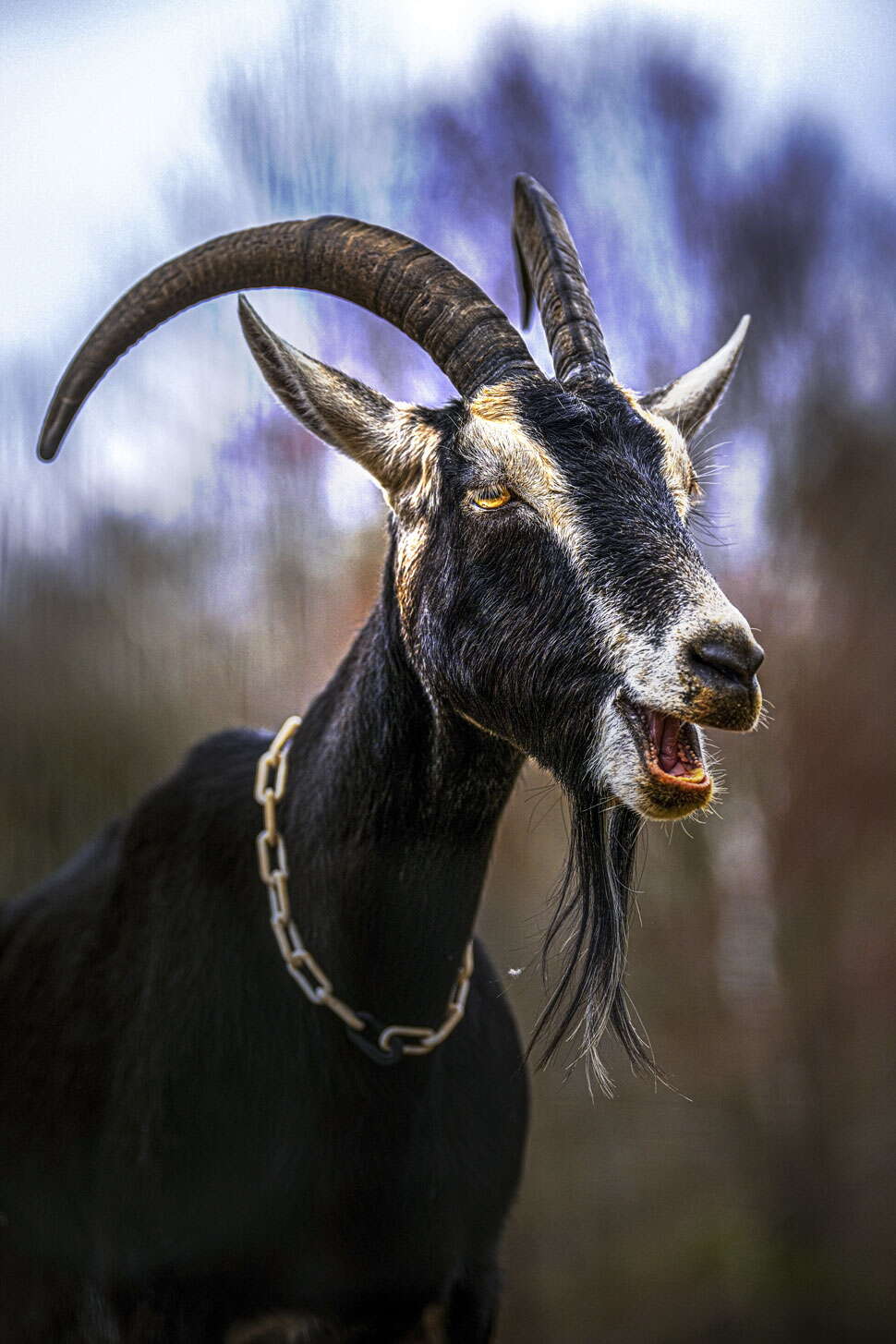













0 Comments